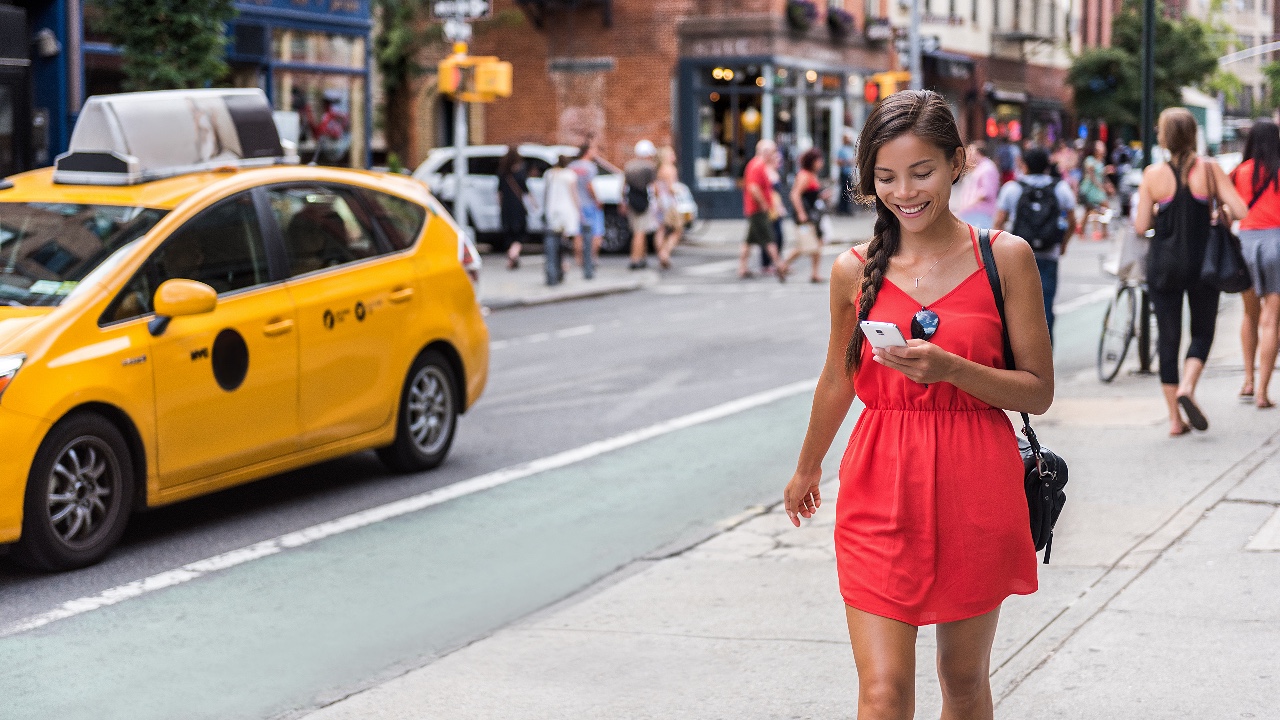The Most (And Least) Walkable Cities in the US

Urbanologists use the term “walkable urbanism” to describe the walkability of a city or metropolitan area. What makes a city walkable? Smart Growth America found out. The Washington, D.C., research group ranked the 35 most walkable cities in the United States in its 2023 Foot Traffic Ahead Report.
The study combined two databases that assigned walkability scores based on people’s ability to walk from their residences to essential “amenities” such as grocery stores, offices, and gyms, as well as the distance between blocks and access to public transportation. The ranking also considers an area’s development density.
Smart Growth graded metro areas on shares of offices, multifamily rentals, retail, for-sale residential, combined, and foot traffic ahead index. Here are the most (and least) walkable cities in the U.S.
Most Walkable Cities

Many of the most walkable cities on the list are on either coast. Some are among the oldest American cities and, as such, were important centers of commerce and education before the advent of the automobile. The most walkable cities have a strong neighborhood culture with small businesses owned by families. These cities also offer robust rail and bus networks.
More urban walkers mean a lesser reliance on cars, which is better for the environment and has health benefits.
New York

The Big Apple scored highest in four categories and was the top walkable city. New York City — the center of finance, media, and fashion — was first in office share, multifamily rental inventory in walkable urban places, retail, and the combined category. The city’s most extensive transportation system is the nation’s largest, with 5.5 million people daily.
In New York, 73% of all office space in the region is in walkable urban places because of the number of corporate headquarters, the largest concentration of financial firms in the world, and a significant technology presence.
Boston

Boston is the biggest city in Massachusetts and the second-most walkable in the nation. Its history goes back almost 300 years to the Puritans’ arrival. It was one of the cradles of the American Revolution. Boston is known for its neighborhoods, such as Back Bay, the North End, Beacon Hill, Chinatown, and Common.
Boston topped all cities with walkable urban housing, and the report cited the large percentage of pre-World War II homes as the reason.
Washington, D.C.

Government, tourism, and technology drive the capital’s economy. Washington, D.C., is a tourist magnet, and the sights they come to see — the White House, Washington Monument, and Lincoln Memorial — are all walkable attractions. Boston, New York, San Francisco, and Washington have extensive mass transit systems and are among the newer subway systems in America.
The capital ranked third on the foot traffic index and third in office share but lower in affordability.
Seattle

Seattle draws visitors because of its vistas, funky image, and generally agreeable weather. Technology, tourism, and aerospace are the main cogs of the Seattle economy. Seattle ranked third in office share and fourth in multifamily rental share.
Like other cities in the Northwest, Seattle’s environmental mindset encourages walkable urbanism. One of the many destinations for walkers is the Underground, a series of tunnels and passageways built under Pioneer Square after the Great Fire of 1889.
Portland

Like Seattle, Portland takes environmental sustainability seriously and encourages walkable urbanism, which environmentalists believe addresses climate change.
Oregon’s most populous city ranked third in retail share behind New York and Miami. Portland was also third in the percentage of walkable urban housing. The city has a well-connected transit network in the central part. However, it is also one of the least affordable, with an average rent of $2,500 and an average home price of $430,000.
San Francisco

San Francisco prides itself on being the most European of American cities. Americans recognize its hilly topography and vistas of the Pacific Ocean, and the city by the bay is known for its socially liberal politics. The innovation hub of Silicon Valley is the engine of the region’s prosperity. The San Francisco Bay Area has various mass transit options, including BART and Caltrain, that enhance its walkability.
San Francisco has the third-highest walkable urban housing and the fourth-highest retail share.
Chicago

Many of America’s most walkable cities are on either coast. An exception is Chicago, nicknamed America’s Second City and the colossus of the Midwest. Manufacturing, information technology, health care, transportation, and finance are the sectors that power the Chicago economy.
A sprawling transportation system, the “L,” is the second largest in the country after New York City, serving 1.6 million riders daily. In the Smart Growth report, Chicago is second in multifamily housing inventory and fifth in office share.
Los Angeles

Los Angeles gets a bad rap as car-centric and not pedestrian-friendly. However, Smart Growth placed the City of Angels eighth on its list of America’s most walkable cities. Los Angeles is the most densely populated metro in the United States. Technology, entertainment, aerospace, manufacturing, and trade drive LA’s economy.
The region recently constructed a regional transit system, an investment of $180 billion. Many of the region’s destinations, such as downtown Los Angeles, downtown Pasadena, Santa Monica, Burbank, Long Beach, and Riverside, were initially designed as walkable urban places.
Pittsburgh

Once the steel titan of the United States, Pittsburgh has shifted into a more technology-focused economy, drawing research and development from its universities, such as the University of Pittsburgh and Carnegie-Mellon.
Pittsburgh’s rail network, known as the “T,” opened in 1984 and covers about 26 square miles. It operates as a subway downtown and a light rail service above ground in the southern neighborhoods. Pittsburgh ranks fifth in office share on the Smart Growth list.
Philadelphia

Philadelphia is America’s first national capital, and many of the country’s most important landmarks and symbols are easily walkable in downtown Philadelphia. Another tourist destination is South Street, known for its Italian restaurants and the city’s signature cheesesteak sandwiches.
Philadelphia’s mass transportation system, SEPTA (Southeastern Pennsylvania Transportation Authority), serves the city. Center City, designed in a street grid by founder William Penn, spans 25 blocks between the Delaware and Schuylkill Rivers. Philadelphia’s five original public squares — Franklin, Washington, Rittenhouse, Logan, and Centre (now City Hall) — lend a European sensibility to the city.
Least Walkable Cities

Most of the least walkable cities are in the Sunbelt states, and the population has exploded in recent decades. Their rapid growth has outpaced urban planning.
The city centers are more car-focused than the more walkable cities on our list and have substandard transit systems, if they have them at all. Urban planners are working to make these cities better examples of walkable urbanism.
Las Vegas

The casino and entertainment metropolis ranked last among the 35 metropolitan areas assessed by Smart Growth. Las Vegas was last in office, multifamily, and walkable urban housing shares.
The Strip is the only high-density, walkable urban area in the city. The arts district and downtown are rebounding, but there is little walkable urbanism outside of downtown.
San Antonio

San Antonio is one of three Texas metro areas with more than 1 million in population. The Alamo and its River Walk are among the city’s main attractions. Smart Growth reports that the success of River Walk is boosting downtown’s vitality.
However, Smart Growth ranks San Antonio as the second-least walkable city on the list. San Antonio is next to last in office and multifamily shares and is one of the lower-ranked cities in retail walkable urban housing shares.
Orlando

Florida is the theme park capital of America, hosting Walt Disney World, Universal Orlando Resort, and SeaWorld Orlando. The U.S. Census reported that the Orlando metropolitan area gained almost 55,000 people between July 2022 and July 2023, the fourth-largest increase of any U.S. metro.
Sunbelt cities are among the urban areas that rank lower on the Smart Growth list, and Orlando is one of them. Orlando ranks well below the average in all categories considered by Smart Growth. The good news for Orlando’s walkability is that the city is developing lakefrontage.
Phoenix

Only Las Vegas ranks lower than Phoenix in its share of walkable urban housing. The desert city grades below average in every Smart Growth category.
An interesting catalyst is boosting urbanism in Arizona’s most populous city. Over the last decade, Arizona State University relocated its business school, law school, and more than 5,000 dorms around a park in downtown Phoenix. The Phoenix light rail line links the downtown campus to the Tempe main campus.
Virginia Beach

The U.S. Navy’s presence has dominated Metro Virginia Beach (including Norfolk and Newport News) for centuries. Naval dominance limits private development around the waterfront.
The metropolitan area is lower than the Smart Growth average in every category. Even so, downtown Norfolk is developing gradually. Urban commercial areas such as Park Place are growing. Highland Park, near Old Dominion University, is an example of walkable urbanism at the university.
Tampa

The U.S. Census reported that the Tampa metropolitan area, which includes St. Petersburg and Clearwater, gained about 51,000 people between July 2022 and July 2023, the fifth-largest increase of any U.S. metro. The city was once famous for its cigar-making factories and agribusiness. Tampa’s economy is more diversified now, with industries such as food processing, electronics, health care, and finance.
Tampa’s walkable neighborhoods include Ybor City, Hyde Park North, Courier City, and the Channel District. However, Smart Growth data indicate that Tampa still has a way to go in walkable urbanism, but access to transit is limited.
Indianapolis

Four metro areas on the list have a walkable urban housing share of less than 2%, and Indianapolis is one of them. Indianapolis, the biggest city in Indiana, uses significant sports events such as the NCAA Tournament and the Super Bowl to increase tourism. The city doubled its hotel space between 1984 and 1991.
The Midwestern metro is revitalizing its downtown and downtown-adjacent areas. The redevelopment of Carmel’s suburban town center is a model of urbanization.
San Diego

San Diego is another American city with a significant U.S. Navy presence. Its world-famous zoo is among its attractions for walkers.
San Diego’s new light rail system investment is paying dividends in walkable urban development. The downtown is still revitalizing. Vibrant downtown-adjacent neighborhoods such as Marina, East Village, and Little Italy border downtown.
Dallas-Fort Worth

Dallas-Fort Worth combined is the second-largest Texas metro area after Houston. The metro is below Smart Growth’s average in all categories. Dallas-Fort Worth is trying to combat its cars-only image by investing extensively in rail transit. Redevelopment in both downtowns occurred in Dallas’ Uptown and Klyde Warren Park.
Like many Sunbelt metros, Dallas-Fort Worth is urbanizing previously drivable suburban areas, making them more walkable.
Detroit

The prolonged decline in the American automobile industry has devastated Detroit. The Motor City’s population fell to 603,000 in 2024 from nearly 1.85 million in 1950. It is the only city on the list whose share of retail is below 1%. Detroit ranks below the Smart Growth average in other categories. Like older industrial cities such as Baltimore, St. Louis, and Cincinnati, Detroit has limited rail transit service.
There are some indications that Detroit has bottomed out. Downtown is revitalizing, and adjacent places, such as Mexicantown, Corktown, and Lafayette Park, are walkable.





